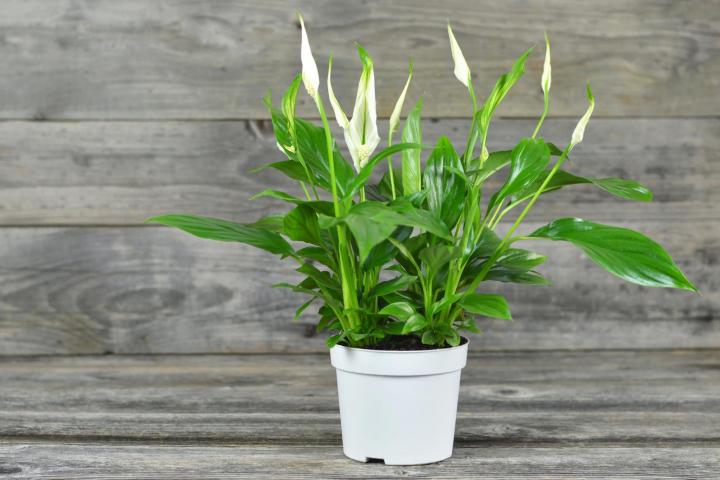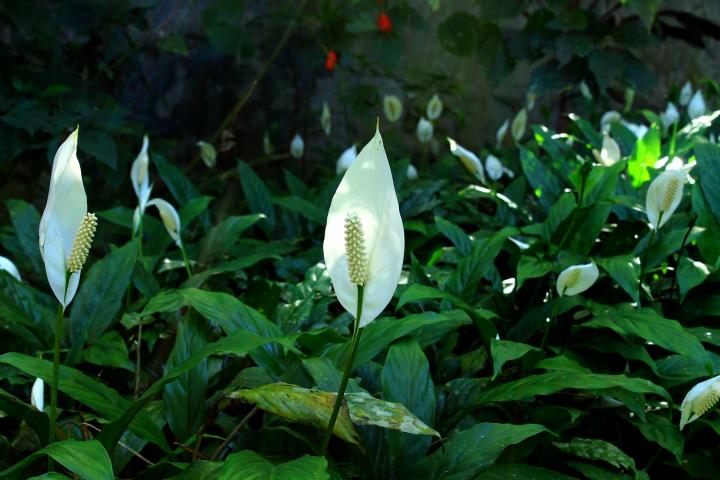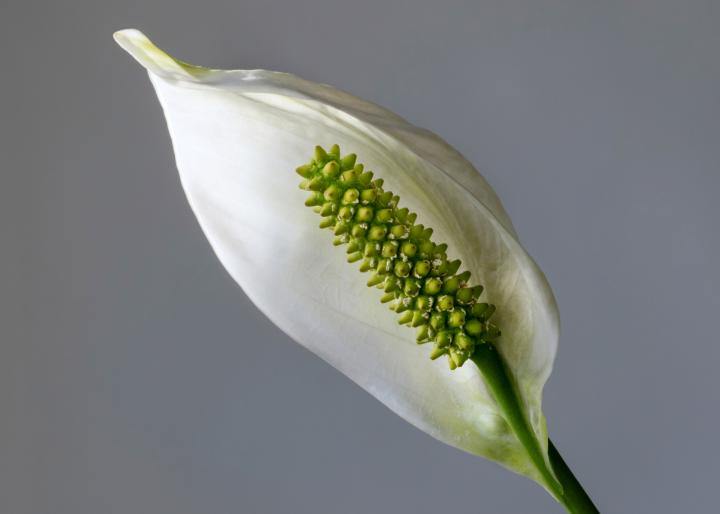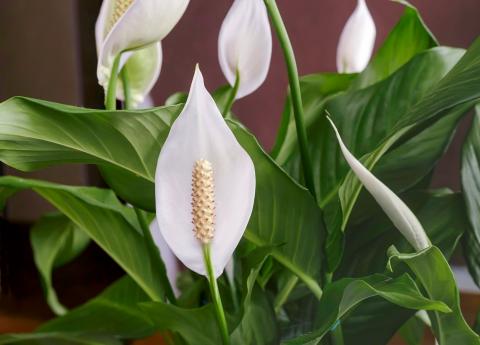Peace lilies are one of the most common houseplants because they’re fairly easy to grow and are beautiful, too! They can be temperamental at times, but once you know how to care for them correctly, a peace lily makes for a lovely addition to any houseplant collection. Here’s everything you need to know about caring for a peace lily in your home.
About Peace Lilies
Peace lilies are tropical, evergreen plants that thrive on the forest floor, where they receive dappled sunlight and consistent moisture and humidity. Replicating these conditions in the home is the key to getting your peace lily to be happy and healthy.
With enough light, peace lilies produce white to off-white flowers starting in the early summer, continuing to bloom throughout the year in the right conditions.
Most household varieties of peace lily grow up to 16 inches tall, but larger outdoor cultivars can have leaves that reach up to 6 feet in height. Peace lilies are not cold-hardy plants, so they can only be grown outdoors in warm, humid climates (USDA Zones 10, 11).
Is the Peace Lily Plant Poisonous?
Yes, peace lilies are mildly toxic. All parts of the peace lily plant contain calcium oxalate—a substance that may cause stomach and respiratory irritation if ingested in large amounts. Keep peace lilies out of reach of small children and pets who might chew on the plant. Other common plants that contain calcium oxalate include philodendrons, daffodils, true lilies, and hyacinths.

How to Plant, Transplant, and Divide Peace Lilies
- Use a well-draining, all-purpose potting soil. The soil should be able to hold moisture and dry out slowly over time. Peace lilies don’t like to dry out entirely, but they also won’t do well if kept in soil that’s constantly wet, as this fosters root rot fungus.
- Repotting the plant every few years in the spring is good for the peace lily, as it will appreciate the refreshed soil.
- Eventually, the peace lily may grow too large for its pot, at which point it can be divided. Remove the plant from its pot and split it into smaller plants, being sure to leave several leaves per clump. Peace lilies grow from rhizomes, so it can tolerate a bit of tough treatment during dividing.
Can Peace Lilies be Grown in Water?
Yes, peace lilies can grow in water alone; they are often sold in vases without any soil. Ideally, the base of the plant should be suspended above the water line, either by a specially-made vase insert or a layer of small river stones. This allows the roots to grow down into the water, but keeps the base of the plant and its leaves from being constantly wet, which can cause rot.
Lighting
- Ideally, keep peace lilies in a spot that gets bright, indirect light. An east-facing window is perfect, as the plant will be exposed to the bright morning sun. A north-facing window would also be a good choice for a peace lily.
- Keep peace lilies out of areas where they’ll get direct sunlight all day (such as in a south-facing window), as it may dry them out too much.
Watering
- When it comes to watering, consistency is key. Keep the soil lightly moist to the touch, but not overly saturated. Peace lilies can tolerate short periods of dry soil, but their leaves will start to develop brown tips if they don’t have enough water or humidity.
- Tip: One nice thing about peace lilies is that they will tell you when they’re thirsty: the plant’s leaves start to droop. When the plant starts to look less “perky” than usual, test the soil with your finger. If it feels dry, it’s time to water again.
- Peace lilies are sensitive to chemicals commonly found in tap water, such as fluoride, which may cause brown leaf tips. Use filtered, room-temperature water, if possible.
Humidity
- Peace lilies enjoy high humidity. Misting their leaves or placing their pot atop a moistened tray of gravel can help to increase humidity around the plant.
Fertilizing
- Peace lilies are not heavy feeders, so fertilize only occasionally. To encourage spring and summer growth, fertilize every 6 weeks or so with a balanced houseplant fertilizer starting in late winter.
Temperature
- Peace lilies are a tropical plant, so keep them in temperatures above 60°F (16°C) and away from cold, drafty windows. They do best in temperatures upwards of 70°F (21°C).
Other Care
- The large leaves of peace lilies tend to collect a lot of dust in the home. Gently wipe them down with a wet paper towel occasionally; a thick layer of dust can inhibit photosynthesis.

How to Get Peace Lilies to Flower
- Most often, if no flowers are appearing, the plant is not getting enough light. Peace lilies are very tolerant of low light, but “low light” doesn’t mean no light! To encourage flowering, move the plant to a brighter location, where it will receive bright, indirect light for at least a few hours each day.
- Green flowers, weak-looking flowers, or a general lack of flowers can also be caused by improper fertilizing. In the case of green flowers, cut back on fertilizing, as the plant may be getting too much nitrogen. In the case of weak-looking flowers or a lack of flowers, try switching to a fertilizer made for flowering plants. This type of fertilizer will have a higher amount of phosphorous, which plants need for blooming.
- Brown leaf tips are commonly caused by excessive direct sunlight, over-fertilization, or lack of water and/or low humidity. Keeping the plant on a tray of moistened gravel or misting the leaves can help to increase humidity.
- Yellow leaves may be caused by overwatering, underwatering, or old age (of the leaf). If the oldest leaves are yellowing and the plant hasn’t been repotted in a while, it may just need more space to stretch its roots.
- Scale and mealybugs will happily take up residence on the plant, if given the opportunity. A thorough wipe-down of leaves with a dish soap and water solution or insecticidal soap can be effective at stopping them, though repeated applications may be necessary.
Specialty varieties of peace lilies are not very easy to come by in most garden centers, though they have been growing in popularity. You may have more success ordering them from an online source.
- Spathiphyllum wallisii is a smaller peace lily, reaching only 12 inches tall.
- ‘Petite’ is smaller still, at approximately 8–10 inches.
- ‘Sensation’ is the largest variety available, capable of growing up to 4–6 feet in height and width.
- ‘Domino’, is a medium-size variety with attractively variegated leaves.
- ‘Mojo Lime’, which has lime-green foliage, is another medium-size peace lily.
- The peace lily is said to have gotten its common name from its white flowers, which rise timidly above its green foliage and resemble white flags of peace.
- Despite the peace lily’s common name, it is not related to true lilies at all.
- The plant’s interesting blooms are also the source of its Latin name, Spathiphyllum, meaning “spathe-leaf.” The flowers consist of the spathe (the white, sheath-like leaf) and the spadix (the spike of small flowers located within the spathe).





